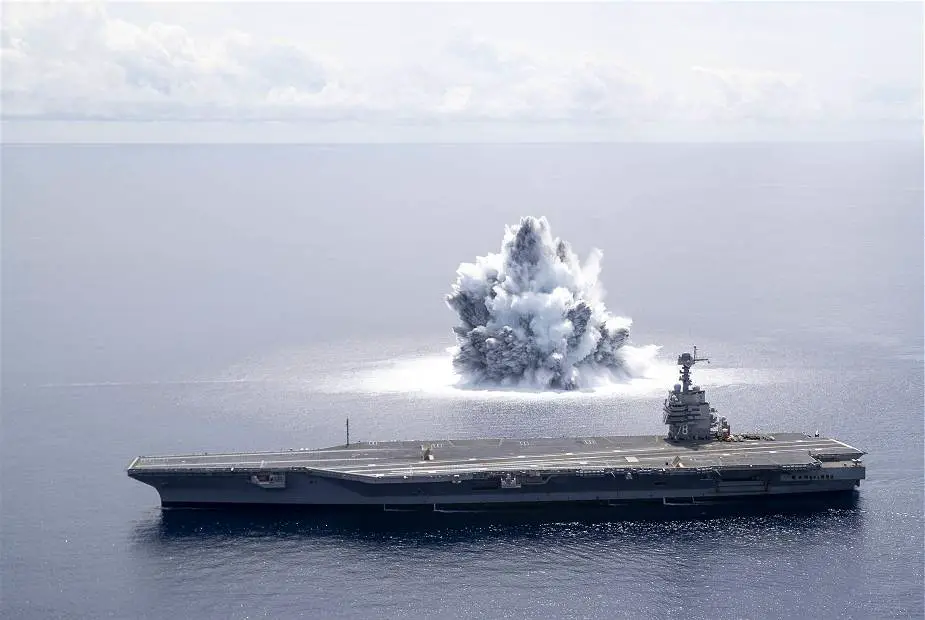According to information published by the U.S. Navy on June 18, 2021, the latest generation of U.S. Navy aircraft carrier USS Gerald R. Ford (CVN 78) successfully completed the first scheduled explosive event as part of Full Ship Shock Trials (FSST).
Follow Navy Recognition on Google News at this link
 The aircraft carrier USS Gerald R. Ford (CVN 78) completes the first scheduled explosive event of Full Ship Shock Trials while underway in the Atlantic Ocean, June 18, 2021. (Picture source U.S. Navy)
The aircraft carrier USS Gerald R. Ford (CVN 78) completes the first scheduled explosive event of Full Ship Shock Trials while underway in the Atlantic Ocean, June 18, 2021. (Picture source U.S. Navy)
The U.S. Navy has conducted FSSTs (Full Ship Shock Trials) over several decades, most recently for the Littoral Combat Ships USS Jackson (LCS 6) and USS Milwaukee (LCS 5) in 2016; as well as for the San Antonio-class amphibious transport dock USS Mesa Verde (LPD 19) in 2008, the amphibious assault ship USS Wasp (LHD 1) in 1990, and the guided missile cruiser USS Mobile Bay (CG 53) in 1987. The last aircraft carrier to execute FSST was USS Theodore Roosevelt (CVN 71) in 1987.
Shock trials are designed to test how U.S. Navy warships hold up against severe vibrations and identify potential shock-related vulnerabilities in a combat vessel. The new Gerald R. Ford-class aircraft carrier was designed using advanced computer modeling methods, testing, and analysis to ensure the ship is hardened to withstand battle conditions, and these shock trials provide data used in validating the shock hardness of the ship.
Ford’s shock trials are being conducted off the East Coast of the United States, within a narrow schedule that complies with environmental mitigation requirements, respecting known migration patterns of marine life in the test area. The Navy also has employed extensive protocols throughout FSST to ensure the safety of military and civilian personnel participating in the testing evolution.
Ford is the newest and most advanced aircraft carrier in the U.S. Navy. The ship closed out a successful 18-month Post Delivery Test & Trials period in April, during which the crew completed all required testing, accomplished planned improvements and maintenance ahead of schedule, and learned valuable lessons to increase the reliability of Ford-Class systems. At the same time, the ship also served as the sole East Coast platform for conducting carrier qualifications.
Upon completion of FSST later this summer, Ford will enter a Planned Incremental Availability for six months of modernization, maintenance, and repairs prior to its operational employment.
The U.S. Navy’s current aircraft carrier force consists of 11 CVNs, including 10 Nimitz-class ships (CVNs 68 through 77) that entered service between 1975 and 2009, and one Gerald R. Ford (CVN-78) class ship that was commissioned into service on July 22, 2017.
The Gerald R. Ford-class aircraft carrier is a new generation of nuclear-powered aircraft carrier built for the U.S. Navy. U.S. Navy has planned to build a total of five Ford-class aircraft carriers including the CVN-78, CVN-79, CVN-80, CVN-81 and CVN-82. The USS Gerald R. Ford (CVN-78) is the lead ship of her class of United States Navy aircraft carriers. She was delivered to the U.S. Navy on 31 May 2017 and formally commissioned by President Donald Trump on 22 July 2017. She is expected to leave on her first deployment around 2023 or 2024.
Citing U.S. Congress report, The Gerald R. Ford (CVN-78) class carrier design is the successor to the Nimitz-class carrier design. The Ford-class design uses the basic Nimitz-class hull form but incorporates several improvements, including features permitting the ship to generate more aircraft sorties per day, more electrical power for supporting ship systems, and features permitting the ship to be operated by several hundred fewer sailors than a Nimitz-class ship, reducing 50-year life-cycle operating and support (O&S) costs for each ship by about $4 billion compared to the Nimitz-class design, the Navy estimates.



